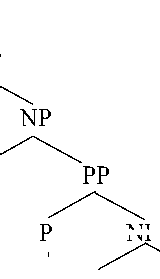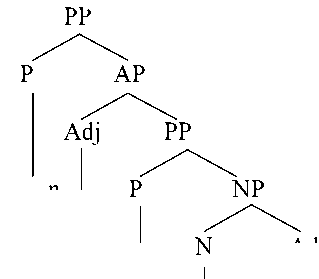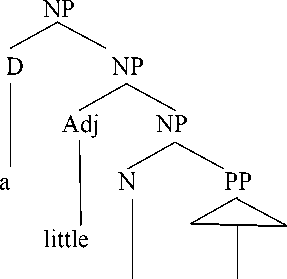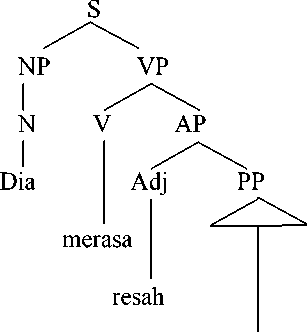CATEGORY SHIFTS IN TRANSLATING ENGLISH COMPLEX NOUN PHRASE INTO INDONESIAN IN OPRAH
on
CATEGORY SHIFTS IN TRANSLATING ENGLISH COMPLEX NOUN PHRASE INTO INDONESIAN IN OPRAH
Ni Ketut Riska Dewi Prawita
Strategic Asia Institute Bali Jl. Drupadi, No.27, Renon, Denpasar (0361) 264241 prawita_riska@yahoo.com
ABSTRACT
This paper aims at analyzing the types of category shifts of complex noun phrase and identifying the types of loss and gain of information. The data was taken from the biography entitled Oprah as the source language, as well as its Indonesian version that has the same title, Oprah, as the target language. It was analyzed by applying the qualitative descriptive method. The categorization of the complex noun phrase was explained by using the tree diagrams. There are two theories applied in this paper, they are the theory proposed by Catford (1965) to analyze the types of category shifts and the theory proposed by Nida (1975) to describe the types of loss and gain of information found in the translation of Oprah.The result of this analysis in the paper indicates that complex noun phrase in English can be translated into Indonesian in two forms, they are complex noun phrase and non-complex noun phrase. Structure shifts and intra system shifts consist of complex noun phrase in translation. Meanwhile, class shifts and unit shifts consist of non complex noun phrase in the translation. Moreover, the occurence of loss and gain of information can not be avoided in the translation.
Keywords: category shifts, complex noun phrase, tree diagrams, and “Oprah”
ABSTRAK
Penelitian ini bertujuan untuk menganalisis tipe pergeseran kategori terjemahan frasa nomina kompleks bahasa inggris ke dalam bahasa Indonesia dan mengidentifikasi jenis pengurangan dan penambahan informasinya. Data penelitian ini diambil dari biografi yang berjudul Oprah sebagai bahasa sumber, serta terjemahan bahasa Indonesianya yang memiliki judul yang sama, Oprah, sebagai bahasa target. Data dianalisis dengan menerapkan metode deskritif kualitatif. Penggolongan dari frase nomina kompleks dijelaskan dengan menggunakan diagram pohon. Ada dua teori yang digunakan dalam penelitian ini, yaitu teori yang dikemukakan oleh Catford (1965) untuk menganalisis jenis pergeseran dalam terjemahan dan didukung oleh teori yang dikemukakan oleh Nida (1975) untuk mengidentifikasi pengurangan dan penambahan informasinya. Hasil penelitian menunjukkan bahwa frase nomina kompleks bahasa Inggris dapat diterjemahkan ke dalam bahasa Indonesia dalam dua bentuk, yaitu frase nomina kompleks dan bukan frase nomina kompleks. Pergeseran struktur dan pergeseran intra system terdiri dari terjemahan frase nomina kompleks. Sedangkan pergeseran kelas dan pergeseran unit terdiri dari terjemahan bukan frase nomina kompleks. Selain itu, terjadinya pengurangan dan penambahan informasi tidak dapat dihindari dalam terjemahan.
Kata kunci: pergeseran kategory, frase nomina kompleks, diagram pohon, dan “Oprah”
INTRODUCTION
Translation has the important role in global communication and it is an effective phenomenon in everyday life. There are many strategies that are used by the translator in transferring the meaning from the source language into the target language. Translation is related to the equivalence, as a consequence of the two differences in linguistic and cultural systems. Shift is the one of the unavoidable phenomenon in translation. Shift is the change that occurs during the process of translation from the source language into the target language. In contrasting texts in different languages translation shifts are observable everywhere. According to Catford (1965: 73), ‘shift’ is the departures from formal correspondence in the process of going out from the source language into the target language. He states that there are two major types of shifts, they are namely level shifts and category shifts. Category shifts involve structure shifts, class shifts, intra system shifts and unit shifts.
The research on translation shifts has ever been done by Susana (2013) but he analyzed translation shifts of locative prepositional phrases. This paper focuses on the types of category shifts and the types of loss and gain of information in translating English complex noun phrase into Indonesian in Oprah biography. This topic is interesting to be discussed since category shifts occur very often in the translation. The aim of this paper is to analyze the types of category shifts and the types of loss and gain of information found in translating English complex noun phrase into Indonesian in Oprah Biography. By conducting this paper, some benefits hopefully can be gained, those are to enlarge the knowledge of category shifts of complex noun phrase from English into Indonesian, as well as the types of loss and gain of information to the readers or the translators, and to be a reference for those who are interested in learning translation studies.
METHOD OF RESEARCH
The books entitled Oprah written by Kitty Kelley and published in 2010, as well as the Indonesian version that has the same title, Oprah, translated by Rina Buntaran and published in 2011 were used as the main data in this paper. The data were analyzed based on the classification of problems which focus on the types of category shifts and the types of loss and gain of information found in translating English complex noun phrase into Indonesian in Oprah biography. The method that is implemented in analyzing the data is the qualitative descriptive method proposed by Djajasudarma (1993). The data was analyzed through several stages. The data was listed in parallel between the source language and the target language after being collected. Then, the complex noun phrases found in the source language and their Indonesian translations were compared. The data was identified and analyzed by applying the theories proposed by Catford (1965). After analyzing the types of category shifts of complex noun phrase found in the translation of Oprah, it focused on the loss and gain of information occurring in the data and it used the theory proposed by Nida (1975).
The data was presented in the form of description in both English as the source language and Indonesian as the target language in informal. In this case, the analysis of the syntactic structure of complex noun phrase was presented by using formal method, which was in the tree diagram proposed by Chomsky (2002) in order to analyze the complex noun phrases occurring in the source language and compare with their Indonesian translations.
DISCUSSION
According to Catford (1965:73), ‘Shifts’ is the departure from formal correspondence in the process of going from the SL to the TL. He divided shift into two categories, such as level shifts and category shifts. In this paper, it focuses on category shifts which refer to unbounded and rank-bounded translation. It includes structure shifts, class shifts, unit shifts, and intra-system shifts.
Structure Shifts
The change of grammatical position of source language in its translation in target language is called structure shifts. According to Catford (1965: 77), these are amongst the most frequent category shifts at all ranks in translation; they occur in phonological and graphological translation as well as in total translation. The following is an example of structure shift found in the bilingual books, Oprah Biography and Oprah.
Data 1
SL: His good friend Gloria Steinem later recalled, “He always said that if he did his job really well, that the next big talk show host in America would be a black woman.” (p.295)
TL: Sahabatnya Gloria Steinem nantinya mengenang, “Dia selalu berkata bahwa apabila dia melakukan pekerjaannya dengan sangat baik, yang akan menjadi pembawa acara talk show besar berikutnya di Amerika adalah seorang wanita kulit hitam.”(p. 314)
CNP in the SL: the next big talk show host
D Premod.1 Premod.2 Premod. 3 Head

besar berikutnya
in America
Post mod.
▼
di Amerika
CNP in the TL: pembawa acara talk show
Head Post mod.1 Post mod.2 Post mod.3 Post mod.4
NP
NP
D
NP
N
NP
the
Adj
NP
Adj NP
pembawa
N
N
NP
NP
next
big
N
N
NP
NP
talk
show
N
acara
talk
N
Adj
PP
show
AP
Adj
AP
PP
P N
besar
P
N
host
in America
berikutnya
di Amerika
(Abbreviation: Adj= Adjective, AP= Adjective Phrase, CNP= Complex noun phrase, D= Determiner, N= Noun, NP= Noun Phrase, P= Preposition, PP= Preposition Phrase, Premod.= Premodifier, Post mod.= Post modifier, SL= Source Language, TL= Target Language)
Complex noun phrase consists of determiner, premodifier, head, and post modifier as can be seen in the source language that complex noun phrase has the constitution of determiner (the), premodifier (next big talk show as a noun phrase), head (hostas a noun), post modifier (in America as a prepositional phrase). This phrase is translated into Indonesian, pembawa acara talk show besar berikutnya di Amerika, which can be categorized into a noun phrase (pembawa acara talk show), an adjective phrase (besar berikutnya) and a prepositional phrase (di Amerika). Based on the explanation above, it is known that there is an occurrence of translation shift in this example in which the grammatical structure in the source language is changed in the target language.
The replacement of the head and modifier position between both languages can be drawn by using the numbers, the source language is the (1), next (2), big (3), talk show (4), host (5), and in America (6), meanwhile in the target language, it can be drawn like pembawa acara (5), talk show (4), besar (3), berikutnya (2), di Amerika (6). It also can be showed from the arrows in the English complex noun phrase, as well as their Indonesian translations. The position of words between the source language and the target language is not the same. In the source language, the word (team) is placed at the back whereas the translation of team in Indonesian (tim) is placed in the front of modifier. Based on theory proposed by Catford (1965), the type of translation shifts in the example is namely structure shift that is the change of the position of word structure in both languages without changing the meaning of the message of the source language. In this case, there is no loss and gain of information found in the translation. The translator translates all words of the source language. No one of information is omitted in the target language. In the translation, the determiner the that has a function as a definite article in the source language is omitted with no loss of information.
Class Shifts
Class shift occurs when the translation equivalence of the source language item is a member of a different class from the original item (Catford, 1965: 78). It is a change the items in both languages which belongs to a different grammatical class. There is an example of class shifts, as follow: Data 2
SL: The paparazzi were always buzzing the farm in helicopters and hiding across the lane with cameras that could catch a perfect picture from a distance. (p.190)
TL: Paparazzi selalu mengintai peternakan dari helikopter dan bersembunyi di seberang jalan dengan kamera yang bisa memotret dengan sempurna dari jarak jauh. (p.212)
|
NP PP D NP P AP Adj NP Adj A N PP Dengan P perfect P NP sempurna picture D N dari from a distance (Abbreviation: CPP= Complex prepositional phrase) |
PP NP N Adj jarak jauh |


|
CNP in the SL: a perfect picture D Premod. Head CPP in the TL : dengan sempurna Prep. Modifier |
from a distance Post mod. ▼ dari jarak jauh Post mod. |
In the example above, the phrase in the source language is a complex noun phrase that has the constitution of determiner (a), premodifier (perfect as an adjective), head (picture as a noun), and post modifier (from a distances as a prepositional phrase). In Indonesian grammar, it is called complex prepositional phrase when it consists of two prepositional phrases, such as this example above that its Indonesian translation is dengan sempurna dari jarak jauh. In this case, the source language text has the different class with the target language text which the translation equivalent of the complex noun phrase in the source language is the complex prepositional phrase in the target language. The type of shift in translation occurs in this translation is class shift and it is based on the theory proposed by Catford. Actually, the translator can translate it into the same phrase, complex noun phrase in Indonesian, therefore, it can be sebuah gambar sempurna dari jarak jauh. However, the translator prefer choose the change of phrase pattern in the target language. Here, the occurrence of loss and gain of information cannot be avoided in the process of translation. Loss of information can be seen from the word picture in the source language that is not translated into Indonesian, gambar. The translator should not omit the head of the phrase, it makes loss of information. In addition, the occurrence of gain of information is showed by adding the word dengan in the target language. It is added by the translator since he chose class shift in the process of translation where the phrase in the target language is translated into different phrase in the target language.
Unit Shifts
According to Catford (1965: 79), unit shift is the change of rank, that is, departures from formal correspondence in which the translation equivalent of a unit at one rank in the source language is a unit at a different rank in the target language. Unit shift includes shifts from morpheme to a word, word to phrase, clause to sentence, and vice versa. The following is the example of unit shift, as follow:
Data 3
SL: “There was a little trepidation on her part in the beginning, which is only natural for someone who has been directed to update her style and improve her image. (p.111)
TL: Dia merasa resah pada awalnya, dan itu normal bagi seseorang telah diinstruksikan untuk memperbaharui citranya. (p.124)
CNP in the SL
: a little trepidation on her part in the beginning
D Premod. Head Post mod.1 Post mod.2

: Dia merasa resah pada awalnya
S P C
Sentence in the TL

trepidation

on her part in the beginning
pada awalnya
(Abbreviation: C= Complement, P= Predicate, S= Subject, V= Verb, VP= Verb Phrase)
As showed by the tree diagrams above, the English complex noun phrase “a litte trepidation on her part in the beginning” is transferred into a sentence “dia merasa resah pada awalnya”. In this case, there is a unit shift in the process of translation. The English complex noun phrase in the source language consist of determiner (a), premodifier (little as an adjective), head (trepidation as a noun), and post modifier (on her part in the beginning as a complex prepositional phrase). It is translated into a sentence which has constitution of a subject (dia as a noun), a predicate (merasa resah as a verb phrase) and a complement (pada awalnya as the prepositional phrase). Because of this translation, this change is called unit shifts. The translator changed the higher rank in the target language that is showed by the change of phrase into a sentence. Loss, gain and skewing of information in the translation also
occur. Loss of information can be identified from the word little in the source language that is not translated into Indonesian, sedikit or agak. It should be translated by the translator therefore there is no loss of information in the target language. Meanwhile, gain of information can be found in the word merasa that has a function as a verb in the Indonesian sentence. The translator should add it in the target language to make the sentence can be accepted by the Indonesian readers. In addition, the occurrence of skewing of information is unavoidable in the process of translation where the prepositional phrase in the source language, on her part, is changed into the Indonesian subject in a sentence, dia. There is no exact equivalent in this translation since the prepositional phrase in the source language is translated into a subject in the Indonesian sentence.
Intra System Shifts
Intra system shift refers to the change that occurs internally within a system. The equivalence is said to occur at a non corresponding term in the target language system. All languages have their systems of number, deixis, articles, etc. intra-system shift happens when a term is singular in the source text and its textual equivalent is plural, or vice versa (a change in number even though the languages have the same number system). There is an example of intra system shifts, as follows:
Data 4
SL: “They had just sucked out of me my inner darkness and were exposing my personal struggles to the entire country,” Rose recalled. (p.390)
TL: “Mereka baru saja mengisap habis kegelapan batin saya dan memaparkan perjuangan pribadi saya kepada seluruh negara,” kenang Rose. (p.417)
CNP in the SL: my personal struggles to the entire country
D Premod. Head Post mod.

CNP in the TL: perjuangan pribadi saya kepada seluruh Negara
Head Post mod.1 D Post mod.2
D
my
NP
NP
NP
N
AP
Adj
NP
Adj
PP
N
PP
perjuangan
D
PP
personal
struggles
P
D
to
the
NP
NP
Adj
entire
pribadi
saya
P
Adj
N
kepada
NP
seluruh
N
negara
country
This example above is a complex noun phrase consisting of determiner (my as the possessive determiner), premodifier (personal as an adjective), head (struggles as a noun), and post modifier (to the entire country as a prepositional phrase). It is translated into a complex noun phrase in Indonesian that has the constitution of a noun phrase (perjuangan pribadi saya), and a prepositional phrase (kepada seluruh negara). There is an occurrence of translation shifts in this example in which intra system shifts occur when a term is singular in the source text and its textual equivalent is plural, or vice versa (a change in number even though the languages have the same number system). It can be seen that the word struggles in the source language that has a function as a plural form is translated into Indonesian, perjuangan, that has a function as a singular form. The repetition is avoided since the reader Indonesian version can understand the meaning clearly. Moreover, loss of information is found in the translation. It can be seen from the word struggles in the source language. As stated above that the word struggles is in plural form whereas its Indonesian translation is in singular form, perjuangan. It should be translated into perjuangan-perjuangan. In this case, the translator avoids the repetition. Omission is required to avoid redundancy and awkwardness.
CONCLUSION
Based on the discussion in the previous section, it can be concluded that complex noun phrase in English can be translated into Indonesian in two forms, they are complex noun phrase and noncomplex noun phrase. All types of category shifts proposed by Catford (1965) is found in the biography, such as structure shifts, class shifts, unit shifts, and intra system shifts. In this paper, Indonesian complex noun phrases as the target language are found in structure shifts, and intra system shifts whereas Indonesian non complex noun phrases are found in class shifts and unit shifts. In addition, the types of loss and gain of information proposed by Nida (1975) usually occur in rendering the meaning of the message from the source language text into the target language text. The differences of the structure of both languages cause the occurence of the loss and gain of information in the process of translation.
REFERENCES
Catford, J.C. 1965. A Linguistic Theory of Translation. London: Oxford University Press Djajasudarama, Fatimah. 2006. Metode Linguistik. Jakarta: Refiko Aditama
Kelley, Kitty. 2010. Oprah: A Biography. New York: The Crown Publishing Group
Kelley, Kitty. 2011. Oprah. Jakarta: Gramedia Pustaka Utama
Nida, Eugene A. and Charles R. Taber. 1975. Theory and Practice of Translation. California: Stamford University Press
Susana, Kadek Yogi. 2011. Shifts in Translation of Locative Prepositional Phrases with Reference to Steve Jobs Biography (Tesis). Denpasar: Udayana University
11
Discussion and feedback